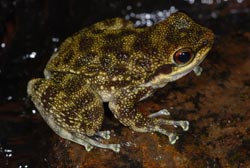Berlin scientists discover new frog family in West Africa

Odontobatrachus natator: one species of the new frog family<br>Photo: Mark-Oliver Rödel <br>
While studying the phylogeny of these frogs, scientists from the Berlin Natural History Museum and their colleagues from Switzerland came across a scientific sensation.
The West African species apparently were not closer related to the other African species. In fact they represent a family already separated from other frog groups since the Cretaceous, the time when dinosaurs dominated life on Earth.
Many new frog species are still discovered and scientifically described each year, in particular from the tropics. Usually not much is known about the biology and phylogeny of these species.
However, the distribution and relatedness of species may deliver important insights to scientist concerning the history of our planet, such as e.g. climate change and the evolution of particular ecosystems. Therefore scientists from the Berlin Museum of Natural History, with their colleagues from Switzerland, aimed at uncovering the phylogeny of African torrent frogs.
These morphologically very similar frogs are specialized on rapidly flowing rainforest streams and waterfalls in West, Central and East Africa. The researchers applied genetic and anatomic methods in their study and were thrilled when they discovered that the West African species apparently were not at all related to the species from the other areas.
Whereas the discovery of new frog species is not unusual, even the identification of a new genus is already very rare. Thus Michael Barej, the first author of the study, stated, that to him it was like “hitting the jackpot. I needed to cool down when we discovered that we might have discovered a new frog family. It felt simply too unreal.”
However, the scientists could indeed show that the West African torrent frogs split from other frogs already in the Cretaceous, the time of dinosaurs. Apart from genetic differences and with the aid of computer tomography Michael Barej and his colleagues also discovered various unique anatomic characters.
Consequently they erected a new frog family, the Odontobatrachidae, for these West African frogs, just published in the scientific journal Frontiers in Zoology. The scientific name of the new family stems from the Greek words for tooth and frog, and is based on an anatomic uniqueness.
The frogs of the new family are characterized by long and bent teeth in the upper jaw and massive fangs in the lower jaw, a very unusual setting for frogs. It is not yet clear what these teeth are used for. Maybe the frogs feed on other frogs, as it might be indicated by the discovery of a small frog skeleton in the stomach of one of the larger individuals.
The discovery of this new frog family is also of importance to the conservation of tropical biodiversity. The “tooth frogs” only occur in small forest remnants in the West African countries of Guinea, Sierra Leone, Liberia and Ivory Coast. Mark-Oliver Rödel from the Berlin Museum of Natural History emphasizes that this discovery further underlines the uniqueness of the West African biodiversity hotspot and he hopes that the new family may be helpful in future efforts to protect these forests, not only for frogs.
The publication „Barej, M.F., A. Schmitz, R. Günther, S.P. Loader, K. Mahlow & M.-O. Rödel (2014): The first endemic West African vertebrate family – a new anuran family highlighting the uniqueness of the Upper Guinean biodiversity hotspot. – Frontiers in Zoology 11:8 doi:10.1186/1742-9994-11-8” is freely accessible at http://www.frontiersinzoology.com/content/pdf/1742-9994-11-8.pdf
Media Contact
More Information:
http://www.naturkundemuseum-berlin.de/enAll latest news from the category: Life Sciences and Chemistry
Articles and reports from the Life Sciences and chemistry area deal with applied and basic research into modern biology, chemistry and human medicine.
Valuable information can be found on a range of life sciences fields including bacteriology, biochemistry, bionics, bioinformatics, biophysics, biotechnology, genetics, geobotany, human biology, marine biology, microbiology, molecular biology, cellular biology, zoology, bioinorganic chemistry, microchemistry and environmental chemistry.
Newest articles

Combatting disruptive ‘noise’ in quantum communication
In a significant milestone for quantum communication technology, an experiment has demonstrated how networks can be leveraged to combat disruptive ‘noise’ in quantum communications. The international effort led by researchers…

Stretchable quantum dot display
Intrinsically stretchable quantum dot-based light-emitting diodes achieved record-breaking performance. A team of South Korean scientists led by Professor KIM Dae-Hyeong of the Center for Nanoparticle Research within the Institute for…

Internet can achieve quantum speed with light saved as sound
Researchers at the University of Copenhagen’s Niels Bohr Institute have developed a new way to create quantum memory: A small drum can store data sent with light in its sonic…





















